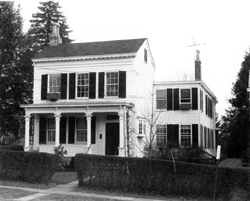Jewish American Historical Places: Albert Einstein House
Princeton, New Jersey
 |
In 1921, the Nobel Prize in Physics was awarded to Albert Einstein, who began pursuing his dream of a unified field theory (an attempt to unify all the fundamental forces and the interactions between elementary particles into a single theoretical framework in physics). Post WWI politics in Germany were volatile, complicated by a severe German economic depression. When the German National Socialist Workers Party under Adolf Hitler came to power, with its anti-Semitic rhetoric and disregard for democratic principles, Einstein emigrated to the United States (which he had first visited in 1921) to accept a position at Princeton’s Institute for Advanced Studies. In the quiet New Jersey town, Einstein intended to lead a life of research and reflection, but once again his international fame required that he travel widely attending conferences and giving lectures. As the racial and totalitarian policies of Hitler’s Germany caused even more refugees to emigrate to the United States, Einstein became active in organizations that provided help. When World War II came, he lent his name and energies to the Allied cause. Einstein retired from the Institute for Advanced Studies in 1945 but continued to live and work in Princeton until his death on April 18, 1955. Albert Einstein was among the most famous scientists of the 20th century. Typical statements about him refer to a man who fundamentally changed the nature of 20th century science and he is given equal ranking with England’s Sir Issac Newton (1643-1727) in the history of physics.
The Albert Einstein House in Princeton, New Jersey, is a simple two-story, “L” shaped frame building with a gabled roof over the front block and a flat roof on the rear block. The exact date of construction and the builder of the Albert Einstein House are unknown, but the home was probably built in the 1870s or 80s. When Albert Einstein first came to Princeton in 1933, he lived at 2 Library Place. In 1936 he purchased 112 Mercer Street. The house remained his home until his death in 1955. 112 Mercer Street was an integral part of Einstein’s work in the United States. Ronald Clark, author of the biography Albert Einstein, wrote “…his room at the Institute (for Advanced Studies) or his study in Mercer Street was his natural habitat. It was here that he could best carry on his main work and continue his stubborn rearguard battle against the new movements in physics which he had started nearly a third of a century ago.” In April 1955 as Einstein lay in the hospital shortly before his death, he is reported to have asked his step-daughter Margot not to make his Princeton house a museum, a request she honored. The Albert Einstein House was designated a National Historic Landmark by the Secretary of Interior on January 7, 1976. Due to the wishes of Albert Einstein, the National Park Service did not publicize this at the time.
Sources: National Parks Service


